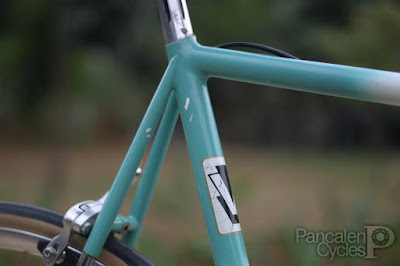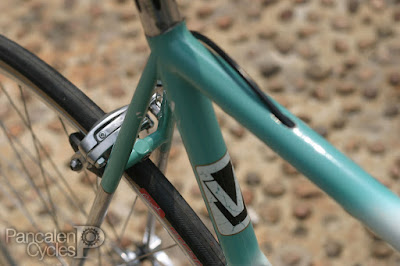At Pancalen Cycles, we believe that bicycles have their own personalities. The large number of people who named their bicycles rest us assured that we're not the only ones who personifies these two-wheeled, human powered machines. When we talk about aged bicycles, they didn't only have their own personalities; they have their own life stories. And this is where things got interesting.
Although the decals said so, turns out that Vitus didn't made this frame. A clue from Stevie Donohue of The Headset Press sheds us some light upon this frame's origin.
The significant feature that distinguish this frame is its split seattube. Just like the rest of the frame, the split seattube was made of Super Vitus 983 tubing—the fork blades, to be exact. This was done to achieve super short chainstay length—so short, you can see the rear tire peeking between these blades. Add the long-ish 58cm seattube length, forward-sloping toptube, and extra short headtube, the chainstays looked even ridiculously short. Mecacycles from St. Etienne, France was the first to came up with this design with their Turbo frames, but a thorough research didn't show us any exactly similar frame out there badged as Mecacycles.
A British-sounding name "Doug Shaw" was written on the toptube. Given the fact that some club racers or professional athletes put their names on their bicycles, perhaps it's safe to say that this fillet-brazed French tubing did saw some action during the late '80s.
 |
| The seattube design echoes the fork crown, creating seamless continuity. |
A British-sounding name "Doug Shaw" was written on the toptube. Given the fact that some club racers or professional athletes put their names on their bicycles, perhaps it's safe to say that this fillet-brazed French tubing did saw some action during the late '80s.
Fast forward to the 21st century. Bought in London during the owner's study, this bicycle was then brought to Jakarta built as a fixed gear conversion. After a long hiatus, the owner wanted to put multiple gears back to the rear wheel, so that's what we did.
The short chainstay length presents us with tight clearance between the chainring and driveside chainstay, so we figured out not to mess with the rear dropout spacing. This leads to the use of a respaced 7-speed Shimano rear hub to retain the 126mm spacing. The frame was designed with no front derailer in mind, so there's only one set of cable routing and downtube shifter boss. To deal with the 7-speed 13-28T cassette, we installed old Shimano 105 rear derailer mated to Shimano indexed downtube shifter.
The frame was designed with French-thread bottom bracket shell, so this is where the bicycle's French identity is retained. TA Specialites crankset and bottom bracket are installed along with Cristophe clips and straps—on MKS pedals, though. We do need to modify TA's 3-bolt 46T 1/8" chainring to fit modern 3/32" chain.
 |
| Holy toe overlap, Batman! |
 |
| We shaved the inner surface of those teeth manually with a die grinder. We're pretty sure you can spot it. |
The steerer was rethreaded to accept JIS headset, and the 22,2mm internal diameter is a welcomed relieve. This allows us to put 70mm Cinelli 1A stem that holds a Modolo bullhorn. As a nod to its previous residence, a West Midlands-made Brooks B17 Titanium saddle is perched atop a Rubis 26,6mm quill-styled seatpost.
 |
| Look Ma, no clamps! |


















No comments:
Post a Comment